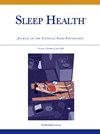A translation and validation study of the traditional Chinese version of RU-SATED scale in Chinese Hong Kong residents
IF 3.4
2区 医学
Q2 CLINICAL NEUROLOGY
引用次数: 0
Abstract
Objective
The Regularity, Satisfaction, Alertness, Timing, Efficiency, and Duration (RU-SATED) version 4.0 is a 6-item tool designed to evaluate sleep health. This study examined the psychometric properties of the traditional Chinese version of RU-SATED (RU-SATED-TC) scale.
Methods
A cross-sectional survey was conducted on December 9, 2023 for 4 weeks. Participants were recruited via a Facebook page to complete an online questionnaire assessing sleep, mental, and physical health. The RU-SATED-TC uses a 5-point Likert scale, with a total score range from 0-24. The psychometric properties of the RU-SATED-TC, including internal consistency, concurrent validity, 1-week test-retest reliability, and factor analysis, were evaluated.
Results
A total of 1043 participants (67.3% female, 55.9% aged 18-39) completed the survey. The average RU-SATED-TC scale score was 12.24 (SD = 3.53). Confirmatory factor analyses showed an acceptable model fit (CFI = 0.94, TLI = 0.89, RMSEA = 0.09, and SRMR = 0.04), supporting a two-factor structure of “consistency and effectiveness” and “timing.” “Efficiency” did not load on any factors. The Cronbach’s alpha was 0.608, with corrected item-total correlations ranged from 0.099-0.530. The “timing” item showed the weakest item-total and concurrent correlations with other sleep outcome measures. The 1-week test-retest reliability was good to excellent (ICCs ranging from 0.605-0.843), except for item 4 (efficiency), which had fair reliability (ICC = 0.464).
Conclusion
The RU-SATED-TC scale appears to be a reliable valid tool for measuring sleep health in Chinese Hong Kong residents. Nevertheless, future research may be needed to refine the “timing” item.
繁体中文ru - sas量表在香港华人中的翻译与验证研究。
目的:规律性、满意度、警觉性、时间、效率和持续时间(RU-SATED) 4.0版是一个包含6个项目的工具,旨在评估睡眠健康。本研究考察了繁体中文RU-SATED量表(RU-SATED- tc)的心理测量特性。方法:于2023年12月9日进行横断面调查,为期4周。研究人员通过Facebook页面招募参与者,让他们完成一份评估睡眠、心理和身体健康的在线问卷。ru - sat - tc采用5分李克特量表,总分范围为0-24分。评估RU-SATED-TC的心理测量特性,包括内部一致性、并发效度、1周重测信度和因子分析。结果:共有1043名参与者完成调查,其中67.3%为女性,55.9%为18-39岁。RU-SATED-TC量表平均得分为12.24分(SD = 3.53)。验证性因子分析显示,模型拟合可接受(CFI = 0.94, TLI = 0.89, RMSEA = 0.09, SRMR = 0.04),支持“一致性和有效性”和“时机”的双因素结构。“效率”没有包含任何因素。Cronbach's alpha为0.608,校正后的项目-总量相关性为0.099-0.530。“计时”一项显示出与其他睡眠结果测量的项目总数和同时相关性最弱。1周重测信度为良至优(ICC范围为0.605-0.843),除第4项(效率)信度为一般(ICC = 0.464)外。结论:RU-SATED-TC量表是衡量香港居民睡眠健康状况的一种可靠有效的工具。然而,未来的研究可能需要完善“时机”项目。
本文章由计算机程序翻译,如有差异,请以英文原文为准。
求助全文
约1分钟内获得全文
求助全文
来源期刊

Sleep Health
CLINICAL NEUROLOGY-
CiteScore
6.30
自引率
9.80%
发文量
114
审稿时长
54 days
期刊介绍:
Sleep Health Journal of the National Sleep Foundation is a multidisciplinary journal that explores sleep''s role in population health and elucidates the social science perspective on sleep and health. Aligned with the National Sleep Foundation''s global authoritative, evidence-based voice for sleep health, the journal serves as the foremost publication for manuscripts that advance the sleep health of all members of society.The scope of the journal extends across diverse sleep-related fields, including anthropology, education, health services research, human development, international health, law, mental health, nursing, nutrition, psychology, public health, public policy, fatigue management, transportation, social work, and sociology. The journal welcomes original research articles, review articles, brief reports, special articles, letters to the editor, editorials, and commentaries.
 求助内容:
求助内容: 应助结果提醒方式:
应助结果提醒方式:


